The black raven is one of the most popular and sinister symbols simultaneously. He is credited with a substantial semantic potential – the bird is both wise and cruel, insidious and impartial. The raven can accompany positive and negative characters, people, and mythical creatures.
In Slavic mythology, the raven is a symbol of death and wisdom. He was called a bird of things, a harbinger of death, battles, and sorrow. It was also believed that the raven had access to ancient knowledge and the power of ancestors. The appearance of a blackbird during memorial and funeral rituals was considered a good sign – the deceased’s soul accepted the offering and honor of the survivors.
There is a version that the raven has become a symbol of death due to its indiscriminate food. A large black bird does not disdain carrion and flies with pleasure to unburied bodies after battles and epidemics. The strong beak of a raven can cause serious injury to a person. Our ancestors also heard the words “coffin” and “blood” in their croaking. The combination of such features could not but envelop the bird in a mystical halo.
Raven – the messenger of Chernobog
Chernobog’s , the god of the world of the dead, was considered the patron saint of ravens. He endowed the bird with a prophetic gift and great knowledge. Chernobog’s pet knew where the sources of living and dead water were, could predict the future.
He also knows the secrets of not only death, but also life. According to legend, the raven accompanies the dead to Nav – the world of the dead. The soul of a deceased person can settle in a bird and return to people in this form, and even Chernobog himself can take on such a look.
In Ancient Russia, the appearance of ravens near human habitation was perceived as an unkind sign:
- birds flock to fields and houses – the year will be bad;
- flew over a person’s head – to imminent death or injury;
- to hear a croak – to bad news;
- to see during funeral ceremonies – the deceased is satisfied and leaves with a pure heart;
- many ravens – for war or pestilence.
The raven was more of a negative symbol, but our ancestors treated him with great respect. For most of its life, this bird tries not to fly to people, and even more so it will not attack a healthy person.
The influence of Christianity on the image of the raven

After the baptism of Rus, the image of the raven acquired a more negative meaning. If earlier people believed that any soul could take up residence in a raven (more often they meant the soul of a warrior), now this belief has transformed – only the souls of evil people, sorcerers, and also those who perished by a “bad” death entered black birds.
The appearance of ravens near human dwellings was now seen as a uniquely disturbing sign, and the black raven finally became a symbol of death and battle. With the onset of feudal fragmentation, and then with the advent of the Tatar-Mongols, the battles became more and more, and the legend of the things of the bird of death was strengthened in the popular consciousness.
In folklore, the image of the things of the bird has been preserved almost unchanged. He accompanied ambiguous fairy-tale characters – Baba Yaga, Marya Morevna, was their totem. Like his patrons, the raven could give wise advice, direct him to the right path, or he could deceive the hero or refuse to talk to him. The bird’s abilities vary in different tales.
Vikings

In Viking mythology, raven symbols are strongly associated with Odin. The Supreme God is accompanied by two prophetic and speaking birds – Hugin and Munin. Every morning, they journey around the planet and the rest of the world, collecting information about what is happening.
The messengers of Odin can not be seen by either people, jotuns, or animals, but they see and hear everything. In the evening, they return to their master and tell everything they have seen.
Preserved images of Odin with one or two crows on his shoulders – for the Vikings, it symbolizes wisdom, awareness and dominion of the supreme god. Odin’s ravens are mentioned in the sagas, the Elder and Younger Edda, the Earth Circle.
It is believed that such a view is associated with the practices of shamanism. During his astral journey, the shaman loses contact with the earthly world and soars above it. The Vikings believed that the soul might not return to the body after such a flight.
Raven on Viking banners
The Vikings loved to depict a raven on their banners, and the meaning of this symbol was highly significant to them. There was a legend about a king who won the battle if the banner fluttered in the wind and lost if there was no wind. Over time, he began to recognize the signs in the behavior of the banner easily and attacked only in favorable weather. Later sagas ascribed foresight to the king.
Most often, Odin’s crows flaunted on the banners of the Vikings – a symbol of wisdom and victory. It was a kind of message to the enemies that all their plans were known and that no amount of force would help them avoid defeat. Death and destruction will occur in their lands, and Odin’s bird can eat plenty of carrion.
Also, the Vikings, like the Slavs, believed that the souls of the dead moved into ravens, and if you call such a soul by name, it will respond. With the adoption of Christianity, the perception of the raven became more damaging – the souls of dishonestly killed or damned people were associated with it.
See our Raven Rings
Celtic mythology
 The symbolism of ravens in Celtic mythology is very close to Scandinavian. The bird accompanies Bran the Blessed, the legendary guardian of the British Isles, the Alder Warrior. This image could be taken by the goddess Morrigan – in this form; she sits on the shoulder of her beloved, the legendary hero with seven pupils. The Druids designated the places of significant rituals with the crow symbol.
The symbolism of ravens in Celtic mythology is very close to Scandinavian. The bird accompanies Bran the Blessed, the legendary guardian of the British Isles, the Alder Warrior. This image could be taken by the goddess Morrigan – in this form; she sits on the shoulder of her beloved, the legendary hero with seven pupils. The Druids designated the places of significant rituals with the crow symbol.
There is a legend that Morrigan came to especially noble warriors and commanders in the form of a beautiful maiden, and in the morning, she flew away in the guise of a raven. Those lucky enough to partner with her won the battles. It was believed that she could inspire some warriors and draw energy and determination from others.
In the legends of King Arthur, there are references to his confrontation with flocks of ravens. In some legends of the cycle, Arthur conflicts with Bran the Blessed, his wife’s father. The ancient warrior is trying to influence the life of Arthur, for which the king ordered him to dig his head out of the grave, which the flocking birds prevent.
The image of the raven in medieval literature

The symbol of the raven in the literature of the Middle Ages is controversial. On the one hand, there were ancient pagan beliefs where the blackbird was associated with the forces of nature. On the other hand, Christian priests sought to supplant pagan symbols and change their meaning to evoke associations with evil. So, the messenger of the ancient gods finally turned into an evil messenger, a harbinger of wars and epidemics.
In the Late Middle Ages and the Renaissance, the image of the raven was superimposed on another – the plague doctor.
Completely closed clothes, a wide black cloak, and a characteristic mask that protected the doctor from contact with patients resembled the silhouette of a giant black bird. So, two images merged into one very similar – sinister and wise simultaneously.
Grim scavengers have become integral to the images of cemeteries, carnage, and other gloomy places. However, ravens were never declared to be creatures and accomplices of evil forces, as with cats.
The Raven in modern culture
What a symbol the raven has become in modern culture is difficult to say unequivocally. In films, books, and games, the reference to the blackbird is often used to create a sad state in the viewer or reader.
The appearance of birds means that the heroes have found themselves in a magical place, on the border of life and death, and soon some frightening event will happen. Found a black feather can start a chain of disturbing mystical events.
The raven has become a kind of emblem of the Gothic subculture, along with the spider and the wolf. He is depicted on clothes, jewelry, interior items, and drawings. The raven embodies gloomy gothic beauty, symbolizing the hopelessness of being.

The Tower of London, famous in England, has its ravens. They are a symbol of the protection of the country. It is believed that if they disappear from the Tower, then the country will undoubtedly overtake trouble.
Therefore, they are looked after, and their reproduction has been monitored for over a thousand years. An ancient legend is so ingrained in England that during the Second World War, when their numbers were significantly reduced, Winston Churchill organized the import of these birds to protect the country.
Our black friends are not as bad as we might think. They are pretty intelligent; these birds were symbols of hope in ancient times, especially in the Roman Empire.
Fact!
The raven skull is a symbol of magical and mystical views. Such an amulet can be worn on the neck, bracelets, earrings, rings. It is not necessary to take a real bird bone, an imitation from any material that the owner likes will do. Silver and cupronickel jewelry are especially popular.
Gothic Jewelry and clothing with symbols have become popular among people who do not consider themselves to this subculture but share the culture’s aesthetics. A raven tattoo symbolizes a magical worldview, the desire for victory, loneliness, and personal strength.
Raven tattoo

Final Thoughts
The raven has acquired a dark and contradictory meaning in culture. This bird symbolizes the balance between life and death, otherworldly forces, unity with nature, and spiritual strength. It is believed that such a symbol is more suitable for men than women; children shouldn’t wear it. It is better to give an amulet with a picture of a raven to well-known people and family members. Outsiders can be upset with such a gift.

Belladonna crafts bewitching blog posts inspired by Gothic elegance, marrying shadow with style. As a discerning researcher, she curates products that echo whispers of moonlit romance. With a playful twinkle in her eye and a quill always at hand, she invites readers to dance on the line between mystery and enchantment.





0 Comments